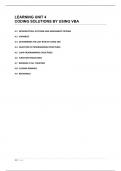Summary
Summary AIN3701 ((LEARNING UNIT 4 CODING SOLUTIONS BY USING VBA))
- Course
- Institution
4.1 INTRODUCTION, OUTCOME AND ASSESSMENT CRITERIA 4.2 VARIABLES 4.3 DETERMINING THE LAST ROW BY USING VBA 4.4 SELECTION OF PROGRAMMING STRUCTURES 4.5 LOOP PROGRAMMING STRUCTURES 4.6 FUNCTION PROCEDURES 4.7 BRINGING IT ALL TOGETHER 4.8 CLOSING REMARKS 4.9 REFERENCES
[Show more]



